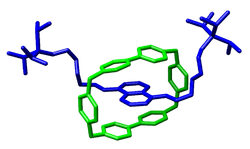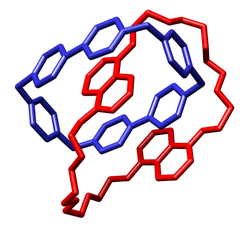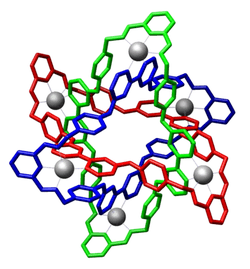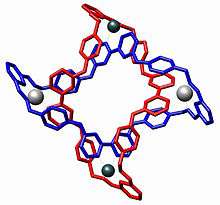Fraser Stoddart
| Sir Fraser Stoddart | |
|---|---|
.jpg) Sir Fraser Stoddart at Nobel press conference in Stockholm, Sweden, December 2016 | |
| Born |
James Fraser Stoddart 24 May 1942 Edinburgh, Scotland, UK |
| Residence | UK, US |
| Nationality | British |
| Citizenship | United States |
| Alma mater | University of Edinburgh |
| Known for | Mechanically interlocked molecular architectures (MIMAs) |
| Spouse(s) |
Norma Agnes Scholan [1][2][3](m. 1968; her death 2004) |
| Children | Two[1] |
| Awards |
|
| Scientific career | |
| Fields | Supramolecular chemistry |
| Institutions |
Queen's University (1967–70) University of Sheffield (1970–1990) University of Birmingham (1990–1997) University of California, Los Angeles (1997–2008) Northwestern University (2008– ) |
| Theses | |
| Doctoral advisor |
|
| Doctoral students | David Leigh[7] |
| Website |
stoddart |



Sir James Fraser Stoddart FRS FRSE FRSC[4] (born 24 May 1942[1]) is a Scottish-born chemist who is Board of Trustees Professor of Chemistry and head of the Stoddart Mechanostereochemistry Group in the Department of Chemistry at Northwestern University in the United States.[8] He works in the area of supramolecular chemistry and nanotechnology. Stoddart has developed highly efficient syntheses of mechanically-interlocked molecular architectures such as molecular Borromean rings, catenanes and rotaxanes utilizing molecular recognition and molecular self-assembly processes. He has demonstrated that these topologies can be employed as molecular switches.[9] His group has even applied these structures in the fabrication of nanoelectronic devices and nanoelectromechanical systems (NEMS).[10] His efforts have been recognized by numerous awards including the 2007 King Faisal International Prize in Science.[11][12] He shared the Nobel Prize in Chemistry together with Ben Feringa and Jean-Pierre Sauvage in 2016 for the design and synthesis of molecular machines.[5][13][14][15][16]
Education and early life
Fraser Stoddart was born in Edinburgh, Scotland, on 24 May 1942. He was brought up on Edgelaw Farm and received early schooling at the local village school in Carrington, Midlothian, before going on to Melville College in Edinburgh.[17][18] He was awarded a Bachelor of Science degree in 1964 followed by a Doctor of Philosophy in 1967[19] from the University of Edinburgh[20] the latter for research on natural gums in Acacias supervised by Edmund Langley Hirst and D M W Anderson.[6]
Career
In 1967, he went to Queen's University (Canada) as a National Research Council Postdoctoral Fellow, and then, in 1970, to the University of Sheffield as an Imperial Chemical Industries (ICI) Research Fellow, before joining the academic staff as a Lecturer in Chemistry. He was a Science Research Council Senior Visiting Fellow at the University of California, Los Angeles (UCLA) in 1978. After spending a sabbatical (1978–81) at the ICI Corporate Laboratory in Runcorn, England, he returned to Sheffield[21] where he was promoted to a Readership in 1982.
He was awarded a Doctor of Science degree from the University of Edinburgh in 1980[22] for his research into stereochemistry beyond the molecule. In 1990, he moved to the Chair of Organic Chemistry at the University of Birmingham and was Head of the School of Chemistry there (1993–97) before moving to UCLA as the Saul Winstein Professor of Chemistry in 1997, succeeding Nobel laureate Donald Cram.[12][23]
In July 2002, he became the Acting Co-Director of the California NanoSystems Institute (CNSI). In May 2003, he became the Fred Kavli Chair of NanoSystems Sciences and served from then through August 2007 as the Director of the CNSI.[23]
During 35 years, nearly 300 PhD students and postdoctoral researchers have been trained in his laboratories.[17]
In 2008, he established the Mechanostereochemistry Group and was named Board of Trustees Professor in Chemistry at Northwestern University.[24]
In 2016, he shared the Nobel Prize in Chemistry together with Ben Feringa and Jean-Pierre Sauvage for the design and synthesis of molecular machines.[5] In 2017, Stoddart introduced a skin care line called "Noble", which utilizes the same Nobel Prize-winning nano-cubes.[25]
Research
One of his major contributions to the development of mechanically-interlocked molecular architectures such as rotaxanes and catenanes has been the establishment of efficient synthetic protocols based on the binding of cyclobis(paraquat-p-phenylene) with electron-rich aromatic guests.[26] His group reported the synthesis of an advanced mechanically interlocked molecular architecture called molecular Borromean rings through the use of dynamic covalent chemistry.[27] The efficient procedures developed to synthesize these molecular architectures has been applied to the construction of molecular switches that operate based on the movement of the various components with respect to one another. These interlocked molecules have potential uses as molecular sensors, actuators, amplifiers, and molecular switches, and can be controlled chemically, electrically, and optically.[28]
His work bridges the gap between chemistry and the scientific and engineering challenges of nanoelectromechanical systems."[29]
Stoddart has pioneered the use of mechanically interlocked molecular architectures to create nanomechanical systems.[30][31] He has demonstrated that such devices can be fabricated using a combination of the bottom-up approach of molecular self-assembly and a top-down approach of lithography and microfabrication.[32]
The credit for making molecular machines attractive to chemists goes to Fraser Stoddart, ... He had the vision to realise that these architectures gave you the possibility of large amplitude-controlled motions, and that that could be the basis of molecular machines. David Leigh[30]
Presentation style
 | |
|
| |
|
| |
|
|
Stoddart's papers and other material are instantly recognizable due to a distinctive "cartoon"-style of representation he has developed since the late 1980s. A solid circle is often placed in the middle of the aromatic rings of the molecular structures he has reported, and different colors to highlight different parts of the molecules. Indeed, he was one of the first researchers to make extensive use of color in chemistry publications. The different colors usually correspond to the different parts of a cartoon representation of the molecule, but are also used to represent specific molecular properties (blue, for example, is used to represent electron-poor recognition units while red is used to represent the corresponding electron-rich recognition units). Stoddart maintains this standardized color scheme across all of his publications and presentations, and his style has been adopted by other researchers reporting mechanically interlocked molecules based on his syntheses.[33][34]
ISI ratings
As of 2016 Stoddart has an h-index of 130.[35] He has published more than 1000 publications and holds at least ten patents.[36] For the period from January 1997 to 31 August 2007, he was ranked by the Institute for Scientific Information as the third most cited chemist with a total of 14,038 citations from 304 papers at a frequency of 46.2 citations per paper.
The Institute for Scientific Information (ISI) predicted that Fraser Stoddart was a likely laureate of the 2003 Nobel Prize in Chemistry along with George M. Whitesides and Seiji Shinkai for their contributions to molecular self-assembly.[37] However, the Prize eventually went to Peter Agre and Roderick MacKinnon.[38]
Awards and honours
Stoddart was appointed a Knight Bachelor in the New Year's Honours December 2006, by Queen Elizabeth II.[21][39] In 2007, he received the Albert Einstein World Award of Science in recognition for his outstanding and pioneering work in molecular recognition and self-assembly, and the introduction of quick and efficient template-directed synthetic routes to mechanically interlocked molecular compounds, which have changed the way chemists think about molecular switches and machines.[40]
Memberships
- 2014 Membership, National Academy of Sciences, USA[41]
- 2012 Fellowship, American Academy of Arts and Sciences, USA[42]
- 2011 Honorary Fellowship, Royal Society of Chemistry, UK[43]
- 2008 Honorary Fellowship, Royal Society of Edinburgh, UK[44]
- 2006 Appointed Knight Bachelor by HM Queen Elizabeth II, UK[39]
- 2006 Foreign membership, Science Division of the Royal Netherlands Academy of Arts and Sciences[45]
- 2005 Fellowship, American Association for the Advancement of Science, USA[46]
- 1999 Fellowship, Academy of Natural Sciences (Leopoldina), Germany[47]
- 1994 Elected a Fellow of the Royal Society of London, UK[4]
Other awards and honours
- 2016 Nobel Prize in Chemistry
- 2016 Haworth Memorial Lectureship, Royal Society of Chemistry[48][49]
- 2014 Centenary Prize Winner, Royal Society of Chemistry[50]
- 2012 Distinguished Citizen Award, Illinois Saint Andrew Society, Chicago, USA
- 2010 Royal Medal of the Royal Society of Edinburgh presented by Duke of Edinburgh[51][52]
- 2008 Davy Medal of the Royal Society of London[29]
- 2008 American Chemical Society Arthur C. Cope Award[53]
- 2007 Feynman Prize in Nanotechnology (Experimental)[54]
- 2007 Albert Einstein World Award of Science[40]
- 2007 Tetrahedron Prize for Creativity in Organic Chemistry[55]
- 2007 King Faisal International Prize in Science[11][12]
- 2007 Jabir Ibn Hayyan (Geber) Medal (Saudi Chemical Society)
- 2005 University of Edinburgh Alumnus of the Year 2005 Award[20]
- 2004 Nagoya Gold Medal in Organic Chemistry[56]
- 1999 American Chemical Society Arthur C Cope Scholar Award [57]
- 1993 International Izatt-Christensen Award in Macrocyclic Chemistry[58]
Personal life
Stoddart is an American citizen. Stoddart married Norma Agnes Scholan in 1968[1][2][3] and has two daughters.
Philanthropy
The Fraser and Norma Stoddart Prize for Ph.D. students has been established at their alma mater, the University of Edinburgh.[2] It was given for the first time in 2013.[59]
References
- 1 2 3 4 STODDART, Sir (James) Fraser. ukwhoswho.com. Who's Who. 1997 (online Oxford University Press ed.). A & C Black, an imprint of Bloomsbury Publishing plc.

- 1 2 3 "Alumnus Presents New Prize for PhD Students". University of Edinburgh. Retrieved 27 May 2016.
- 1 2 "Norma Stoddart (Obituary)". The Scotsman. 16 February 2004. Retrieved 27 May 2016.
- 1 2 3 Anon (1994). "Sir James Stoddart FRS". royalsociety.org. London: Royal Society. Archived from the original on 2016-08-15.
One or more of the preceding sentences incorporates text from the royalsociety.org website where:
All text published under the heading 'Biography' on Fellow profile pages is available under Creative Commons Attribution 4.0 International License." --"Royal Society Terms, conditions and policies". Archived from the original on 25 September 2015. Retrieved 9 March 2016.
- 1 2 3 Staff (5 October 2016). "The Nobel Prize in Chemistry 2016". Nobel Foundation. Retrieved 5 October 2016.
- 1 2 3 "James Fraser Stoddart: Curriculum Vitae, Full Version" (PDF). stoddart.northwestern.edu. Archived from the original (PDF) on 2016-10-05.
- ↑ "2009 winner of the RSC Merck Award". Royal Society of Chemistry. Retrieved 6 October 2016.
- ↑ "Nanotechnology Star Fraser Stoddart to Join Northwestern". NewsCenter. Northwestern University. 2007-08-16.
- ↑ A. Coskun, M. Banaszak, R. D. Astumian, J. F. Stoddart, B. A. Grzybowski, Chem. Soc. Rev., 2012, 41, 19–30
- ↑ A. Coskun, J. M. Spruell, G. Barin, W. R. Dichtel, A. H. Flood, Y. Y. Botros, J. F. Stoddart. Chem. Soc. Rev., 2012, 41 (14), 4827–59.
- 1 2 "Stoddart Wins King Faisal International Prize". Chemical & Engineering News. 85 (12): 71. 19 March 2007. Retrieved 26 May 2016.
- 1 2 3 "Fraser Stoddart is awarded the 2007 King Faisal International Prize for Science". California NanoSystems Institute. 17 January 2007. Archived from the original on 10 February 2007.
- ↑ Chang, Kenneth; Chan, Sewell (5 October 2016). "3 Makers of 'World's Smallest Machines' Awarded Nobel Prize in Chemistry". New York Times. Retrieved 5 October 2016.
- ↑ Davis, Nicola; Sample, Ian (2016-10-05). "live". the Guardian. Retrieved 2016-10-05.
- ↑ The Nobel Prize in Chemistry 2016
- ↑ Van Noorden, Richard; Castelvecchi, Davide (2016). "World's tiniest machines win chemistry Nobel". Nature. London: Springer Nature. 538: 152–153. Bibcode:2016Natur.538..152V. doi:10.1038/nature.2016.20734. PMID 27734892.
- 1 2 Capecelatro, Alex N. (2007). "From Auld Reekie to the City of Angels, and all the Meccano in between: A Glimpse into the Life and Mind of Sir Fraser Stoddart" (PDF). The UCLA USJ. 20.
- ↑ "It's all Kids Stuff". FP News, The magazine and Annual Review of The Stewart's Melville FP Club. Daniel Stewart's and Melville College Former Pupils Club. December 2014. pp. 13–14. Retrieved 29 July 2015.
- ↑ Stoddart, James Fraser (1967). Studies on plant gums of the Acacia group (PhD thesis). University of Edinburgh.
- 1 2 "2005 – Professor J Fraser Stoddart". The University of Edinburgh. Retrieved 26 May 2016.
- 1 2 Marcus, Jennifer (4 January 2007). "UCLA's J. Fraser Stoddart Adds Knight Bachelor to His List of Honors". UCLA Newsroom.
- ↑ Stoddart, James Fraser (1980). Some adventures in stereochemistry (DSc thesis). University of Edinburgh. OCLC 605975820.

- 1 2 Wolpert, Stuart (6 November 2003). "UCLA Chemist Fraser Stoddart Named Director of California NanoSystems Institute". UCLA Newsroom.
- ↑ news.northwestern.edu/stories/2016/10/fraser-stoddart-awarded-nobel-prize-in-chemistry/
- ↑ "Nobel Prize winner introduces skin care line". December 5, 2017. Retrieved July 4, 2018.
- ↑ J. F. Stoddart, Chem. Soc. Rev., 2009, 38, 1802–1820
- ↑ K. S. Chichak, S. J. Cantrill, A. R. Pease, S.-H. Chiu, G. W. V. Cave, J. L. Atwood, J. F. Stoddart, Science, 2004, 304, 1308–1312
- ↑ "UCLA's J. Fraser Stoddart on Switching to Molecular Electronics" (PDF). Science Watch. 16 (5). 2005. Retrieved 27 May 2016.
- 1 2 "Award Winners Davy Medal". The Royal Society. Retrieved 26 May 2016.
- 1 2 Richards, Victoria (16 February 2016). "Molecular Machines". Chemistry World.
- ↑ Madou, Marc J. (2009). From MEMS to bio-MEMS and bio-NEMS : manufacturing techniques and applications. Boca Raton, Fla.: CRC. pp. 131–133. ISBN 9781420055160. Retrieved 27 May 2016.
- ↑ Stoddart, J. F.; Tseng, H.-R. (12 March 2002). "Chemical synthesis gets a fillip from molecular recognition and self-assembly processes". Proceedings of the National Academy of Sciences. 99 (8): 4797–4800. Bibcode:2002PNAS...99.4797F. doi:10.1073/pnas.052708999. PMC 122671. PMID 11891314.
- ↑ "Fraser Stoddart: Mingling Art with Science". Ste(a)m Connect. Retrieved 27 May 2016.
- ↑ Brough, B.; Northrop, B. H.; Schmidt, J. J.; Tseng, H.-R.; Houk, K. N.; Stoddart, J. F.; Ho, C.-M. (30 May 2006). "Evaluation of synthetic linear motor-molecule actuation energetics". Proceedings of the National Academy of Sciences. 103 (23): 8583–8588. Bibcode:2006PNAS..103.8583B. doi:10.1073/pnas.0509645103. PMC 1482623. PMID 16735470.
- ↑ "1040 Highly Cited Researchers (h>100) according to their Google Scholar Citations public profiles". Ranking Web of Universities. Retrieved 27 May 2016.
- ↑ STODDART, James Fraser. "List of Publications" (PDF). Northwestern University. Retrieved 27 May 2016.
- ↑ "Leading Information Solutions Provider Predicts Nobel Laureates; Thomson ISI Citation Laureates are Contenders for 2003 Nobel Prizes". BusinessWire. 29 September 2003. Retrieved 27 May 2016.
- ↑ "The Nobel Prize in Chemistry 2003 Yves Chauvin, Robert H. Grubbs, Richard R. Schrock". The Royal Swedish Academy of Sciences. Retrieved 7 October 2016.
- 1 2 "Ma'am to the Rescue". Stoddart Mechanostereochemistry Group. 2007-06-13. Retrieved 2009-01-19.
- 1 2 "Prof. Sir Fraser Stoddart". World Cultural Council. Retrieved 6 October 2016.
- ↑ "Sir J. Fraser Stoddart, Professor Emeritus of Chemistry and Biochemistry at UCLA, has been elected to the National Academy of Sciences (NAS)". UCLA. 1 May 2014.
- ↑ Anyaso, Hilary Hurd (18 April 2012). "Faculty Members Named AAAS Fellows". Northwestern News.
- ↑ "Who our members are". Royal Society of Chemistry. Retrieved 27 May 2016.
- ↑ "Directory 2016/2017" (PDF). Royal Society of Edinburgh. Retrieved 27 May 2016.
- ↑ "J.F. Stoddart". Royal Netherlands Academy of Arts and Sciences. Archived from the original on 14 February 2016. Retrieved 14 February 2016.
- ↑ "UCLA Members of the American Association for the Advancement of Science". UCLA. Retrieved 26 May 2016.
- ↑ "List of Members: Sir J. Fraser Stoddart". Leopoldina. Retrieved 26 May 2016.
- ↑ "Sir J. Fraser Stoddart to deliver Haworth Memorial Lecture". Royal Society of Chemistry. Retrieved 7 October 2016.
- ↑ "Serendipity in science". Royal Society of Chemistry. Retrieved 3 November 2016.
- ↑ "Centenary Prize 2014 Winner Professor Sir Fraser Stoddart Professor Sir Fraser Stoddart". Royal Society of Chemistry. Retrieved 26 May 2016.
- ↑ "Royal Medallists". The Royal Society Of Edinburgh. Retrieved 26 May 2016.
- ↑ Fellman, Megan (3 August 2010). "Sir Fraser Stoddart Honored With Royal Medal". Northwestern University.
- ↑ "Arthur C. Cope Award". American Chemical Society. Retrieved 26 May 2016.
- ↑ "2007 Foresight Institute Feynman Prize". Foresight Institute. Archived from the original on 17 March 2016. Retrieved 26 May 2016.
- ↑ "Tetrahedron Prize for Creativity". Elsevier. Retrieved 26 May 2016.
- ↑ "The Nagoya Medal of Organic Chemistry" (PDF). Nagoya University. Retrieved 26 May 2016.
- ↑ "Arthur C. Cope Scholar Awards". American Chemical Society. Retrieved 26 May 2016.
- ↑ "Izatt-Christensen Awards". Brigham Young University. Retrieved 26 May 2016.
- ↑ "First Ever Fraser and Norma Stoddart Prize". University of Edinburgh. Retrieved 24 May 2013.
| Wikimedia Commons has media related to Fraser Stoddart. |
